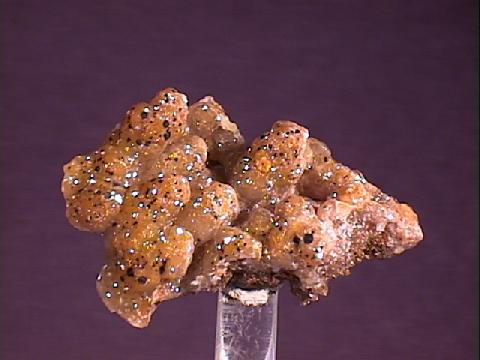
SMITHSONITE
Specimen smi-56
$ 25.00
Dims: 1.89 x 1.1 x 0.7" (4.7 x 2.8 x 1.7 cm)
Wt: 22.7 g
Hilarion Adit, Agios Constantinos, Laurion, Greece
This large thumbnail specimen consists of a section of botryoidal Smithsonite crust. It is in good condition, though one spot does seem to be lightly damaged, and it shows good botryoidal form. The crust has a red-brown color that is likely caused by rusty inclusions, and shows the characteristic "melted wax" luster. It is dappled with dull, black spots of some other mineral and appears to hold a small amount of brown or black goethite or limonite on its underside.
 Amethyst Galleries' Mineral Gallery MINERALS |
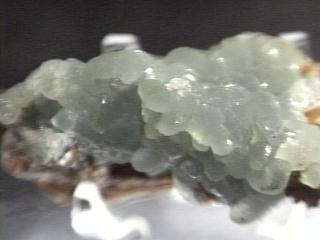
SMITHSONITE specimen smi-2
$ 65.20
$ 65.20
Dims: 2-1/2 x 1" x 1/2"
Wt: 2.9 oz
Kelly Mine, New Mexico, U.S.A.
This is one of our prettiest New Mexico Smithsonite pieces; it is tall and thin, and the word "stalactitic" comes to mind. It has a rusty matrix, with tiny, botyroidal formations in between the larger globules of pale, blue-green Smithsonite, which cover about 1/3 of the specimen's surface area. Then, of course, there's that inimitable, silky, "melted wax" luster that I simply adore!

smi-2 ($ 65.20)
Kelly Mine, New Mexico, U.S.A.
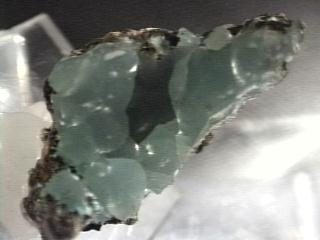
SMITHSONITE specimen smi-4
$ 52.50
$ 52.50
Dims: 1-3/4" x 1" x 1"
Wt: 1.4 oz
Kelly Mine, New Mexico, U.S.A.
Another exemplary specimen of our New Mexican Smithsonite, this piece has its blue, botryoidal masses in a convex base, giving it some modicum of protection. The color is a comparatively darker blue than that of most of our other specimens, and possesses that "melted wax" sheen that I hold so dear. This will really make a great addition to a collection, especially with that dark, aqua color.

smi-4 ($ 52.50)
Kelly Mine, New Mexico, U.S.A.
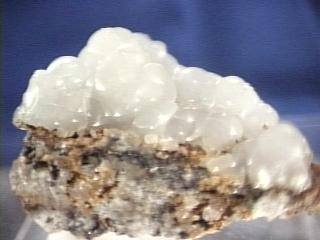
SMITHSONITE specimen smi-5
$ 63.00
$ 63.00
Dims: 2-1/4" x 2-1/2" x 1"
Wt: 3 oz
Kelly Mine, New Mexico, U.S.A.
This is my favorite Smithsonite specimen. I dig Smithsonite, and I can look at this piece for hours, with its white, botryoidal formations that have that incredible "melted wax" sheen to them. I like any mineral with a botryoidal form anyway, but this one just does it for me.

smi-5 ($ 63.00)
Kelly Mine, New Mexico, U.S.A.
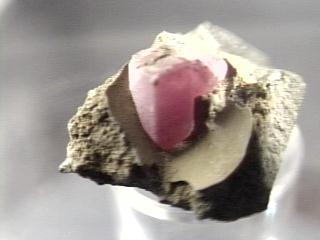
SMITHSONITE specimen smi-6
$ 45.00
$ 45.00
Dims: 1" x 3/4" x 5/8"
Wt: 13.1 g
Chihuahua,Mexico
This little piece simply confuses the bejeebers out of me! I've never seen such a large (5/16 inch long by 1/4 inch wide), single crystal of Smithsonite before, and on top of that, it has that sheen that I adore so much! I almost get the feeling that this is a crystal that has been coated with a layer of microcrystals, but I'd need a powerful microscope to be able to tell. This piece is the only one we could find of this sort, and we're not sure if we can get more.

smi-6 ($ 45.00)
Chihuahua,Mexico
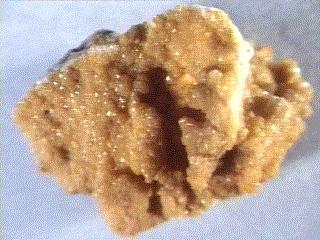
SMITHSONITE specimen smi-8
$ 40.00
$ 40.00
Dims: 3-1/8" x 2-1/4" x 1-7/8"
Wt: 9.8 oz
Tsumeb, Namibia
Yet another very unusual Smithsonite specimen, this piece has about 75% of its surface area covered with yellow-gold Smithsonite crystals that are large enough to easily see with the naked eye. Needless to say, there is no "melted wax" sheen, but the color and size of the crystals (not to mention the African locality) certainly make for a captivating specimen! There is one area on the specimen that has taken the form of a shallow "tunnel" that goes through the specimen. This "tunnel", needless to say, is lined with the golden crystals.

smi-8 ($ 40.00)
Tsumeb, Namibia
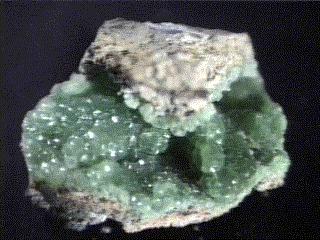
$ 140.00
Dims: 2-1/2" x 2-1/2" x 1-1/4"
Wt: 6.42 oz
79 Mine, 400 Steppe, Hayden, Gila Co., Arizona, U.S.A.
I've just found a new "favorite Smithsonite" specimen! The fact that it doesn't come from New Mexico, and that it comes from the 79 Mine, a known lead-mineral locality makes it a bit unusual. Besides, the color is splendid, being located somewhere between a grass-green and the yellow-green of peridot. Of course it has that lush, "melted wax" luster that drives me insane. Like other Smithsonite specimens, the botryoidal formations are somewhat protected by overhangs that make crevices for the mineral to hide in.

79 Mine, 400 Steppe, Hayden, Gila Co., Arizona, U.S.A.
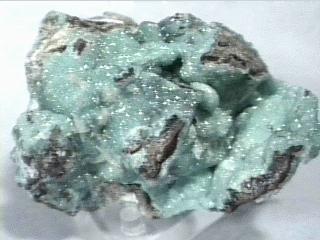
SMITHSONITE specimen smi-11
$ 75.00
$ 75.00
Dims: 3-1/2" x 3-1/8" x 1-5/8"
Wt: 13.9 oz
Hidden Treasure Mine, Tooele Co., Utah, U.S.A.
There are many botryoidal Smithsonite clusters on this specimen. They are all colored a similar blue-green, with some spots being rather pale, possibly due to weathering. The individual crystals are too large to give the clusters the characteristic "melted wax" luster, but they do give them a gentle sparkle. There are several clusters of bladed crystals of an unidentified mineral on the Smithsonite crust-- my guess is that it is calcite, but I'm not positive. These bladed clusters make a pretty specimen even more intriguing!
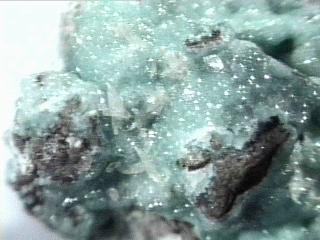

smi-11 ($ 75.00)
Hidden Treasure Mine, Tooele Co., Utah, U.S.A.
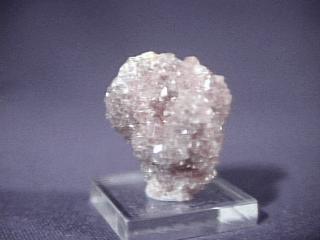
SMITHSONITE specimen smi-14
$ 60.00
$ 60.00
Dims: 1.2" x 1.88" x 0.88"
Wt: 1.24 oz.(35.4 g.) w/ base
Tsumeb, Namibia
This Smithsonite specimen has the distinction of having extremely large, visible crystals. They are pink colored and have a pearly to vitreous luster. They are slightly cloudy but still show transparence, and occur in what appears to be a rhombohedral shape, but their crystal faces have noticeable curvature. These crystals attain a maximum size of about 1/4 x 3/16"(6 x 5 mm). They are generally in good condition, though close inspection reveals a few areas of damage. The specimen is hot-glued to an acrylic base. I like to see specimens like this- I'm so used to seeing botryoidal Smithsonite from New Mexico.

smi-14 ($ 60.00)
Tsumeb, Namibia
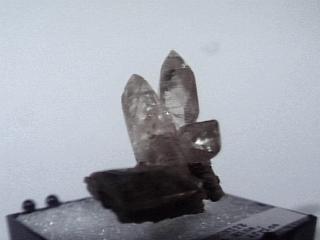
SMITHSONITE specimen smi-16
$ 28.00
$ 28.00
Dims: 0.9" x 0.7" x 0.9"(2.3 x 1.8 x 2.3 cm)
Wt: 7.7 g. w/ specimen box
Tsumeb, Namibia
Perhaps one of the simplest Smithsonite pieces that I have seen, this specimen has only 5 crystals. By Smithsonite standards, though, they are huge! The smallest of these crystals is about 0.4"(1.0 cm) in length, and the largest is just about 0.75"(1.9 cm) long. They have near-perfect form and occur as long hexagonal prisms with steep trigonal pyramidal terminations. There are very subtle, thin secondary faces along the termination edges. The largest crystal shows a small amount of damage along one of its termination edges right near the tip, but I believe that this is naturally occurring. A bit of rust- or hematite-stained matrix accompanys the crystals, which is glued into a plastic specimen box for protection. I think that this is a special piece- these crystals are in great condition for their size!

smi-16 ($ 28.00)
Tsumeb, Namibia
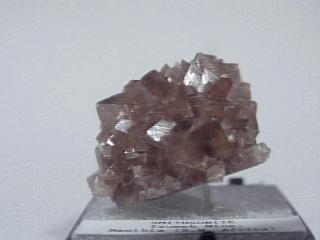
SMITHSONITE specimen smi-17
$ 50.00
$ 50.00
Dims: 1.1" x 0.9" x 0.6"(2.8 x 2.3 x 1.5 cm)
Wt: 19.6 g. w/ specimen box
Tsumeb, Namibia
At least 10 very large crystals of Smithsonite inhabit this Namibian specimen. They have the form of chubby trigonal pyramids that almost have a pseudocubic appearance. Their color ranges from a pale brown to pink, with the brown coloration actually occupying a layer over the pink, so that very subtle phantoms might be seen inside the crystals. Of course this means that they are transparent to some extent. There is an abscence of striations on their faces and they have a pearly luster. The largest of these crystals has visible dimensions of about 1/4 x 1/4" (6 x 6 mm), and most of the larger ones have some very minor damage on their tips. There is no host rock and the specimen is affixed to the inside of a plastic specimen box for protection. I really like the coloration on this specimen, as well as the chubby crystals.

smi-17 ($ 50.00)
Tsumeb, Namibia
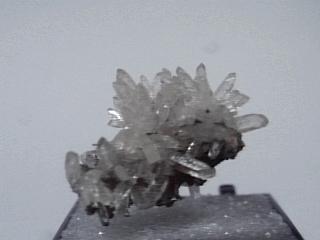
SMITHSONITE specimen smi-18
$ 28.00
$ 28.00
Dims: 1.1" x 0.8" x 0.9"(2.8 x 2.0 x 2.3 cm)
Wt: 9.4 g. w/ specimen box
Tsumeb, Namibia
At least 20 thin, colorless Smithsonite crystals make up this specimen. They have good clarity but are heavily striated, so it is not easy to see through them. They do not exceed 1/4"(6 mm) in length and have a hexagonal prismatic form with a steep trigonal pyramidal termination. Though their forms may be slightly warped, I cannot see any damage except at the point where the specimen was separated from its native environment. There is a small but visible phenomenon that is quite bizarre; when viewed with a bright overhead light at the correct angle, a small spot of color will appear in one of the crystals- actually, I saw it in more than one, but only very faintly in the other. I imagine that it has something to do with the light being refracted by the strange striations along each crystal.

smi-18 ($ 28.00)
Tsumeb, Namibia
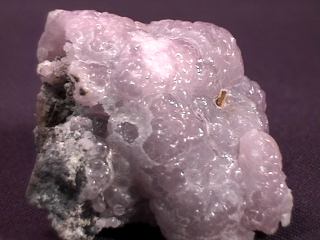
SMITHSONITE specimen smi-20
$ 48.00
$ 48.00
Dims: 1.6" x 1.4" x 1.3"(4.1 x 3.6 x 3.3 cm)
Wt: 2.80 oz.(79.4 g>)
Sinola, Durango, Mexico
This Smithsonite specimen from Durango, Mexico has a moderate pink color that deepens slightly in some areas. It has a botryoidal form that is odd in the fact that large nodular formations that make up the crust are made up of smaller botryoidal formations that have grown together. It has the "melted wax" luster that I hold so dear, and is quite translucent. The crust partially covers a base rock that is rather soft and granular, and is likely some type of decayed limestone. It has a rather bright color that pleases me.
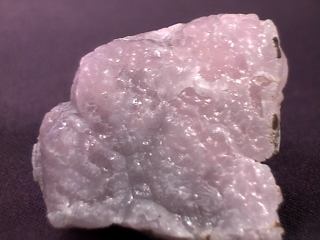

smi-20 ($ 48.00)
Sinola, Durango, Mexico
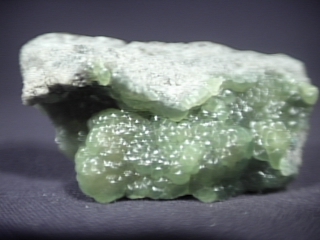
SMITHSONITE specimen smi-22
$ 70.00
$ 70.00
Dims: 2.5" x 1.5" x 1.3"(6.4 x 3.8 x 3.3 cm)
Wt: 4.36 oz.(123.6 g)
79 Mine, Hayden, Gila County, Arizona, U.S.A.
This lovely green crust contains the most transparent botryoidal Smithsonite that I have ever seen. Its color is grass-green with a hint of yellow, and has the obligatory silky, "melted wax" luster, but is dimly transparent, enough so that the base rock seems to affect the crust's coloration. The base rock itself seems to be made up of finely-grained Smithsonite globules that are packed together, giving it a range of color from gray to brown to a greenish-yellow, with the consistency of sandstone. The crust is very shiny, shinier than many formations of this mineral that I have seen.

smi-22 ($ 70.00)
79 Mine, Hayden, Gila County, Arizona, U.S.A.
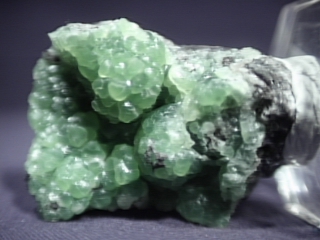
$ 190.00
Dims: 2.1" x 1.7" x 0.6"(5.3 x 4.3 x 1.5 cm)
Wt: 3.03 oz.(85.9 g) w/ base
79 Mine, Hayden, Gila County, Arizona, U.S.A.
This Smithsonite specimen has the deepest green color that I have seen in this mineral. It is a straight grass-green in coloration and is translucent. It occurs in a crust made up of hundreds of botryoidal nodules. Those that rest on the edges of the specimen are broken, and one can see the acicular, radial tendencies of the tiny crystals. It has the silky, "melted wax" luster that is sought after by collectors, and shows little damage besides that on the crust's edges. The crust coats a layer of smaller, dull-yellow-colored botryoidal Smithsonite that covers part of the dark gray matrix, which may be composed mostly of even more Smithsonite! The specimen is attached to an octagonal acrylic base with a removable putty. It is one of the most beautiful examples of Smithsonite that I have seen yet.

79 Mine, Hayden, Gila County, Arizona, U.S.A.
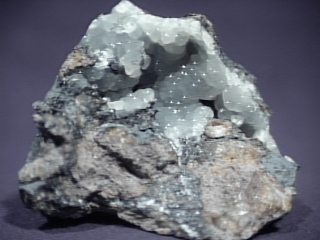
SMITHSONITE specimen smi-27
$ 65.00
$ 65.00
Dims: 3.9" x 3.4" x 2.9"(9.9 x 8.6 x 7.4 cm)
Wt: 1 lb., 1.5 oz.(496 g)
MMM Open Pit, Broken Hill Mine, New South Wales, Australia
The base rock of this specimen consists of a combination of massive, rust-stainded quartz and gray, metallic goethite. There is a hollow in this matrix that is coated with a thick layer of botryoidal Smithsonite formations. The dozens of globules that make up this formation are colorless and faintly white, have the characteristic "melted wax" luster, and are not quite transparent. Only the exposed edges of this formation show any damage- most of it is protected inside the deep hollow that it coats. There are several smaller, mostly-damaged patches of it scattered on the host rock. It is a beautiful and large specimen with a generous amount of Smithsonite.

smi-27 ($ 65.00)
MMM Open Pit, Broken Hill Mine, New South Wales, Australia
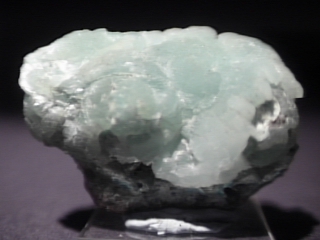
SMITHSONITE specimen smi-30
$ 38.00
$ 38.00
Dims: 2.3" x 1.8" x 1.1" (5.8 x 4.6 x 2.8 cm)
Wt: 3.70 oz. (105.1 g)
Kelly Mine, New Mexico, U.S.A.
This is one of the more bizarre Smithsonite specimens from the Kelly Mine in the southwestern U.S. that I have come across. It appears upon first glance to consist of a crust of blue-green botryoidal Smithsonite coating a base of hematite or limonite. However, this "base" contains a considerable amount of more Smithsonite, and could be mostly Smithsonite by weight, though that is difficult to discern. The Smithsonite that makes up the outer shell has a rather dull luster, with only small areas showing any of the beautiful "melted wax" sheen. It is translucent, and its coloration intensifies in the lower, earlier layers. A few small and very bright aqua-blue sprays of the mineral show its compact, fibrous, and radial habit. This specimen warrants some further study, I think.
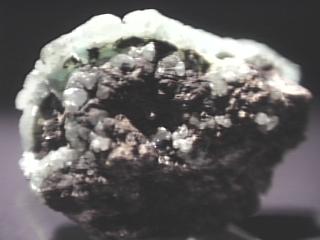

smi-30 ($ 38.00)
Kelly Mine, New Mexico, U.S.A.
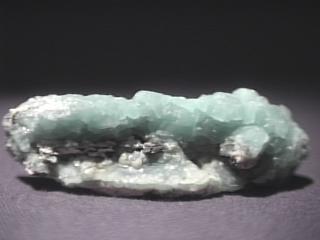
SMITHSONITE specimen smi-31
$ 38.00
$ 38.00
Dims: 2.9" x 1.1" x 0.9" (7.4 x 2.8 x 2.3 cm)
Wt: 1.71 oz. (48.4 g)
Kelly Mine, New Mexico, U.S.A.
The botryoidal Smithsonite on this specimen partially coats a rather long, thin section of host rock that I believe is made up partially of iron oxide minerals. The Smithsonite has a moderately deep blue-green coloration and excellent form, occurring as small botryoidal globules that are tightly intergrown. Though appearing a bit dull, the lovely "melted wax" sheen is still evident on most of the crust. The material is translucent and its compact, fibrous, radial habit is visible along one section of the crust where it was broken off of its place of formation.

smi-31 ($ 38.00)
Kelly Mine, New Mexico, U.S.A.
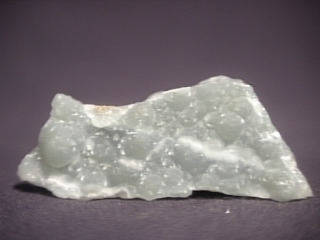
SMITHSONITE specimen smi-32
$ 32.00
$ 32.00
Dims: 2.5" x 1.1" x 0.4" (6.4 x 2.8 x 1.0 cm)
Wt: 1.29 oz. (36.6 g)
Kelly Mine, New Mexico, U.S.A.
A very thin layer of an unknown material makes up the base of this specimen. It is covered on both of its sides by crusts that are made up of intergrown botryoidal formations of Smithsonite. The Smithsonite crusts are each only about 0.2" (5 mm) thick, so the entire piece is rather thin. These crusts have a pale blue-gray coloration, are translucent, and have the classic "melted wax" luster of Smithsonite, though it is not as bright as some that I have seen. The sides of the piece where it was broken out of its place of formation show the compact acicular, radial habit of this mineral. The material in a small area on one side of the piece is paler colored than the rest of the material, due to a thin crust that has coated it.
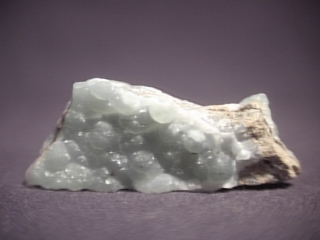

smi-32 ($ 32.00)
Kelly Mine, New Mexico, U.S.A.
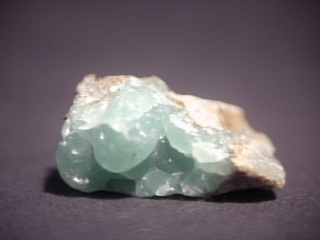
SMITHSONITE specimen smi-33
$ 37.00
$ 37.00
Dims: 2.0" x 1.3" x 1.0" (5.1 x 3.3 x 2.5 cm)
Wt: 1.88 oz. (53.3 g)
Kelly Mine, New Mexico, U.S.A.
On a base rock that consists of densely packed limestone chunks and fine semi-botryoidal Smithsonite lays a small but thick crust of beautiful blue-green Smithsonite. The crust is made up of intergrown botryoidal globules, the largest of which measures about 0.6 x 0.4 x 0.4" (1.5 x 1.0 x 1.0 cm). All have the wonderfully bright blue-green color and the velvety "melted wax" luster, and show definite transclucence. The faces on the sides of the crust where it was separated from its host rock show the mineral's compact acicular, radial habit, and one can actually see its layered color zonation in one spot. Though not very large, it is quite pretty.

smi-33 ($ 37.00)
Kelly Mine, New Mexico, U.S.A.
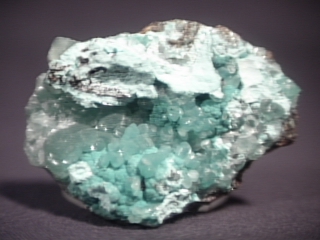
SMITHSONITE specimen smi-34
$ 80.00
$ 80.00
Dims: 2.6" x 1.8" x 0.8" (6.6 x 4.6 x 2.0 cm)
Wt: 2.67 oz. (75.9 g)
Kelly Mine, New Mexico, U.S.A.
One of the most impressive Smithsonite specimens that I have seen for its size, this piece consists of a flat base rock of decayed, rust-stained carbonate material that is nearly completely coated on one side with blue-green Smithsonite. The Smithsonite occurs as a crust that is made up of many small, botryoidal nodules that are intergrown. They have the standard silky, "melted wax" sheen and are translucent. There are a few different layers of this material that are visible, some of which have paler or deeper colors and much duller lusters. I am wondering if any of this material is actually hemimorphite, as the two are often associated with each other.

smi-34 ($ 80.00)
Kelly Mine, New Mexico, U.S.A.
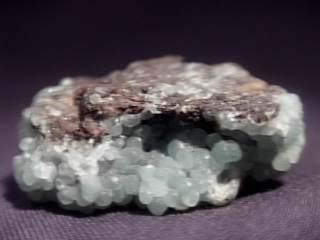
SMITHSONITE specimen smi-35
$ 35.00
$ 35.00
Dims: 2.0" x 1.4" x 0.7" (5.1 x 3.6 x 1.8 cm)
Wt: 1.73 oz. (49.3 g)
Kelly Mine, New Mexico, U.S.A.
This small hand specimen consists of a what I think used to be a crevice in a host rock that was filled with small botryoidal Smithsonite formations. Most of the host rock later wore away, leaving a "cast" of Smithsonite. The Smithsonite is in the form of small blue globules that are heavily intergrown with each other and do not exceed 3 mm in diameter. They have the silky, "melted wax" luster that is sought after in this mineral, and are translucent. Though there is some noticeable damage, the cluster is still generally in very good condition. Some of the host rock is still present on the sides of the specimen, and appears to be made out of some type of oxide mineral, as the piece is rather heavy for its size.
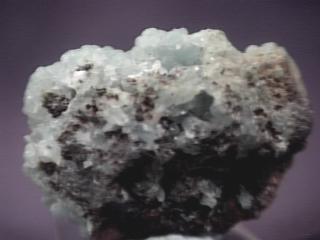

smi-35 ($ 35.00)
Kelly Mine, New Mexico, U.S.A.
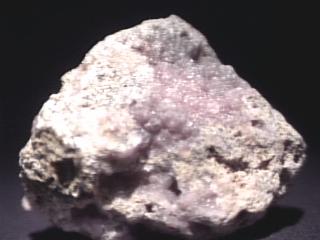
SMITHSONITE specimen smi-37
$ 24.00
$ 24.00
Dims: 2.2" x 2.0" x 1.1" (5.6 x 5.1 x 2.8 cm)
Wt: 4.47 oz. (126.8 g)
Chihuahua, Mexico
The grainy, weathered, pale-brown host rock of this specimen contains several crusts of pink, botryoidal Smithsonite. A few of these crusts show damage in the form of scuffing, but most are in very good condtion, as they line protective crevices. The botryoidal formations do not generally exceed 3 mm in diameter, but have good form and the "melted wax" luster that one expects from this mineral. Most of the crusts are translucent, but the largest one shows dim transparence. There is actually quite a large amount of Smithsonite on this specimen- the more I examine it, the more I see.
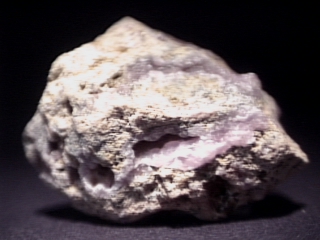

smi-37 ($ 24.00)
Chihuahua, Mexico
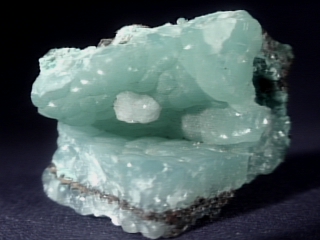
SMITHSONITE specimen smi-38
$ 85.00
$ 85.00
Dims: 2.3" x 1.9" x 1.7" (5.8 x 4.8 x 4.3 cm)
Wt: 4.75 oz. (134.6 g)
Kelly Mine, Socorro County, New Mexico, U.S.A.
This lovely specimen is mostly Smithsonite by weight- there are only a few thin crusts of the dark brown host rock present. The Smithsonite itself is in the form of botryoidal crusts that range in thickness from 0.2- 0.4" (5- 10 mm). It shows no damage other than the breakage that separated the specimen from its place of origin. It has a dull pearly luster that is a bit duller than that of most Smithsonite I have seen from this locality. Its color is a moderately pale greenish-blue and it is translucent. The backside of one of the crusts is visible and shows what appears to be considerable weathering or water wear. On the front of this particular crust is a small (0.4 x 0.3 x 0.2" or 1.0 x 0.8 x 0.5 cm), white formation of tiny crystals. I don't know exactly what they are, though they could possibly be a later formation of more crystalline Smithsonite. I think that it is one of the more attractive specimens that we have from the Kelly Mine.
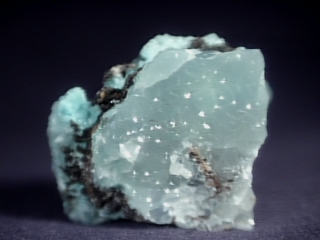

smi-38 ($ 85.00)
Kelly Mine, Socorro County, New Mexico, U.S.A.
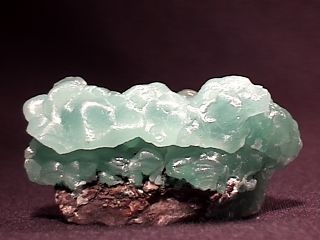
SMITHSONITE specimen smi-39
$ 135.00
$ 135.00
Dims: 2.0" x 1.2" x 1.0" (5.1 x 3.0 x 2.5 cm)
Wt: 1.47 oz. (41.7 g)
Kelly Mine, Socorro County, New Mexico, U.S.A.
This large thumbnail specimen has one of the more intriguing formations of Smithsonite on it that I have seen. The piece consists of a base of broken, gray rock that is partially coated with a layer of green-blue Smithsonite that has a botryoidal form and a lovely, "melted wax" luster. On top of this layer is another, smaller coating of Smithsonite with the same color, though it appears to be a bit brighter. It almost seems as if the layers have undergone considerable wear, likely due to water, as their shapes are condusive to their botryoidal form. On one side of the specimen, where the Smithsonite meets the host rock, there are several small spots of material that have a dull luster and a much deeper, more intense green-blue color. It is an intriguing little piece.
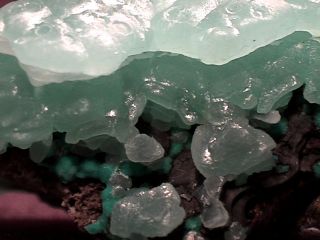

smi-39 ($135.00)
Kelly Mine, Socorro County, New Mexico, U.S.A.
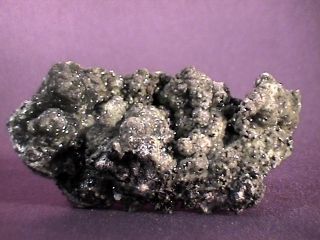
SMITHSONITE specimen smi-40
$ 65.00
$ 65.00
Dims: 3.1" x 1.6" x 1.5" (7.9 x 4.1 x 3.8 cm)
Wt: 5.24 oz. (148.5 g)
79 Mine, Hayden, Gila County, New Mexico, U.S.A.
This hand specimen consists of one or more layers of botryoidal Smithsonite that cover part of a chalky, dull brown host rock. Though showing excellent form and patches of a beautiful, silky luster, most of the Smithsonite on this specimen shows a dull, waxy luster and a very dull, olive-green-to-brown coloration. Due to the layer's thinness, the material does not show any noticeable translucence. There are, however, many tiny, colorless crystals scattered on this Smithsonite layer. Under 15x magnification, they all appear to have a generally tetragonal, tabular form. They are probably calcites with a warped, flattened form, but I would like to think that they are possibly wulfenites, though I have never heard of them being colorless.
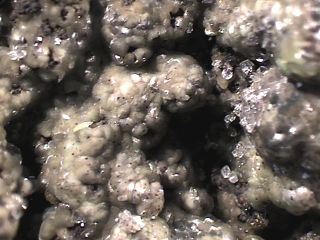

smi-40 ($ 65.00)
79 Mine, Hayden, Gila County, New Mexico, U.S.A.
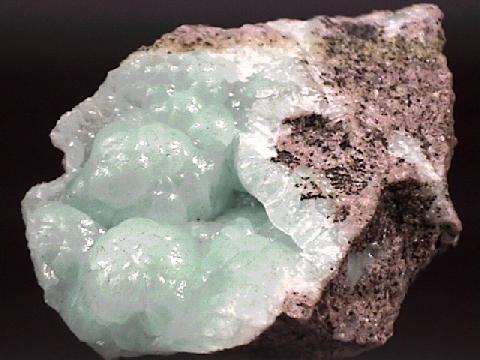
SMITHSONITE specimen smi-41
$ 32.00
$ 32.00
Dims: 2.0" x 1.4" x 0.9" (5.1 x 3.6 x 2.3 cm)
Wt: 1.39 oz. (39.7 g)
Kelly Mine, New Mexico, U.S.A.
The granular, pale brown host rock of this specimen is partially covered with a thin layer of botryoidal Smithsonite. It shows good form and no damage except for the breakage surfaces on the edges of the crust. It has a pale blue coloration and shows a pearly luster that is dulled in some places due to dirt and slight wear. There are a few smaller, thinner patches of Smithsonite elsewhere on the host rock, but these do not have as good a color or form as the larger crust.

smi-41 ($ 32.00)
Kelly Mine, New Mexico, U.S.A.
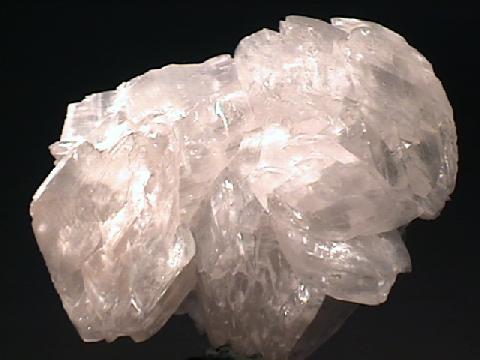
SMITHSONITE specimen smi-42
$ 63.00
$ 63.00
Dims: 1.2" x 0.9" x 0.5" (3.0 x 2.3 x 1.3 cm)
Wt: 5.7 g
Tsumeb Mine, Namibia
This small thumbnail specimen consists of a cluster of large, round bladed Smithsonite crystals. These crystals achieve diameters of 0.5" (1.3 cm) and are in excellent condition, showing almost no damage. They have a pale pink coloration and a pearly luster and show excellent trigonal bladed form, though intense intergrowth interrupts and warps their form somewhat. All are transparent and dimly clear though the material is slightly foggy and shows noticeable internal cleavage planes. There is a small amount of a metallic mineral on the pieces cut underside. I have no idea what this material is.

smi-42 ($ 63.00)
Tsumeb Mine, Namibia
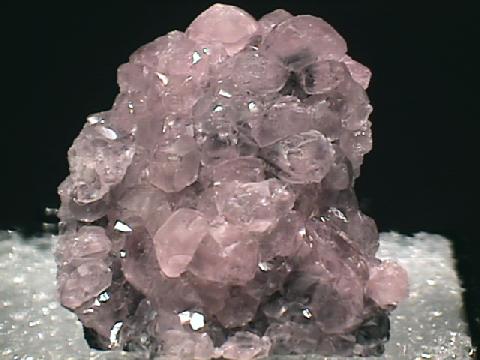
SMITHSONITE specimen smi-43
$ 45.00
$ 45.00
Dims: 0.9 x 0.9 x 0.3" (2.3 x 2.3 x 0.8 cm)
Wt: 16.8 g w/ specimen box
Tsumeb Mine, Namibia
This small thumbnail specimen consists of a small crust that is made up of rounded but definitely crystalline Smithsonite. These crystals do not exceed 0.2" (5 mm) in diameter and are generally in very good condition, as damage is confined to the crystals on the edges of the crust. They have good trigonal form, with moderately well-defined edges and clean faces, but I cannot determine what particular form this is, as the crystals appear to have taken on an almost cubic form! They have a pale pink coloration and a bright pearly-to-vitreous luster, and are dimly transparent. The underside of the crust is coated with a layer of very small black crystals that have a rather dull submetallic luster- besides this, there is no host rock. The specimen is hot-glued to the inside of a cubic plastic specimen box.

smi-43 ($ 45.00)
Tsumeb Mine, Namibia
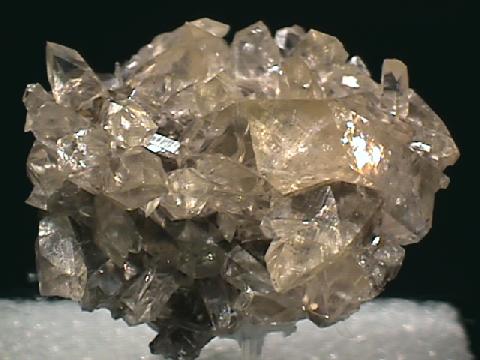
SMITHSONITE specimen smi-44
$ 60.00
$ 60.00
Dims: 1.1 x 0.9 x 0.6" (2.8 x 2.3 x 1.5 cm)
Wt: 20.1 g w/ specimen box
Tsumeb Mine, Namibia
This thumbnail specimen consists of a small section of crust that is made up of dozens of trigonal prismatic Smithsonite crystals. These crystals achieve dimensions of up to 0.6 x 0.3 x 0.3" (1.5 x 0.8 x 0.7 cm) and are generally in excellent condition, as only the crystals on the specimen's edge show any damage. All have excellent form, with sharp edges and lightly striated but smooth and clean faces that possess a bright pearly-to-vitreous luster. All have a pale ecru coloration and are transparent and quite clear, though each contains visible cloudy inclusions and some internal fractures. It almost looks as if Smithsonite crystals grew off of both sides of a thin base of limonite! The specimen is attached inside a cubic plastic specimen box with hot glue.

smi-44 ($ 60.00)
Tsumeb Mine, Namibia
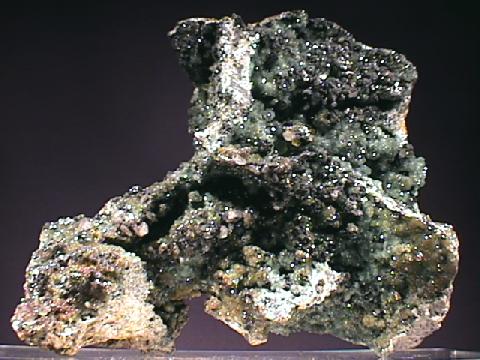
SMITHSONITE specimen smi-45
$ 150.00
$ 150.00
Dims: 7.0 x 6.3 x 3.7" (17.8 x 16.0 x 9.4 cm)
Wt: 5.7 lbs. (2.6 kg)
Durango, Mexico
One of the larger Smithsonite speicmens that we have had available, this cabinet piece consists of a rather dull, pale-brown host rock that is partly covered with a crust of round, heavily-intergrown Smithsonite blades. These blades are so intergrown that they create almost reniform formations, but they are large enough (up to 0.1" or 3 mm diameter) to be easily seen. They are generally in excellent condition, as the crust shows damage only in a few small, highly-exposed areas. The crystals show very good form for their intergrowth, as the rounded trigonal blades have sharp edges and smooth faces that possess a pearly-to-vitreous luster. All have a moderately pale green coloration with a hint of blue, and are translucent to dimly transparent. They are not alone, though; on top of the Smithsonite crust rest many cerussite prisms and wulfenite blades. All show excellent form after their own habits and almost no damage. The cerussite has the standard cream-color, adamantine luster, and cloudy translucence, and the wulfenite blades are a pale yellow-orange and are transparent, with a vitreous luster. Scattered widely among these crystals are many formations of a dull black material that I cannot identify. I would think that it was made up of plattnerite, given the association to the other lead minerals, but it has a positively dull luster, and crystals are difficult to discern and warped due to heavy intergrowth. I would think that it is a lead-based mineral, though, as the host rock contains a substantial amount of galena.
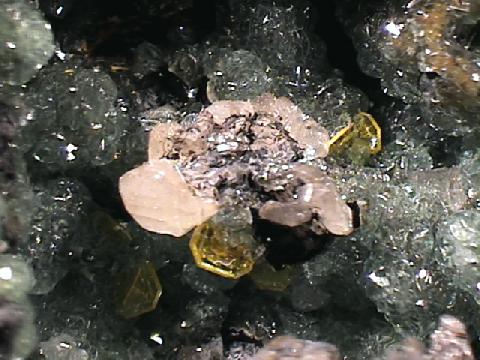

smi-45 ($150.00)
Durango, Mexico
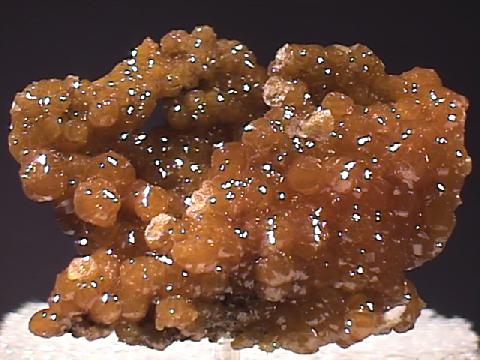
SMITHSONITE specimen smi-46
$ 55.00
$ 55.00
Dims: 1.1 x 0.9 x 0.3" (2.8 x 2.3 x 0.8 cm)
Wt: 17.5 g w/ specimen box
Tsumeb Mine, Namibia
This thumbnail specimen consists of a thin, reniform crust that is made up of scores of intergrown Smithsonite nodules. These nodules do not exceed 2 mm in diameter and are generally in excellent condition- I can see only one nodule on the crust that is damaged. All have crystalline tendencies and almost look like intergrown hessonite garnets, as their color is red-gold with a hint of brown in some areas. Their luster is bright and almost adamantine, and all are generally translucent. There is no host rock present, and the crust is affixed inside a cubic plastic specimen box with a hot glue.

smi-46 ($ 55.00)
Tsumeb Mine, Namibia
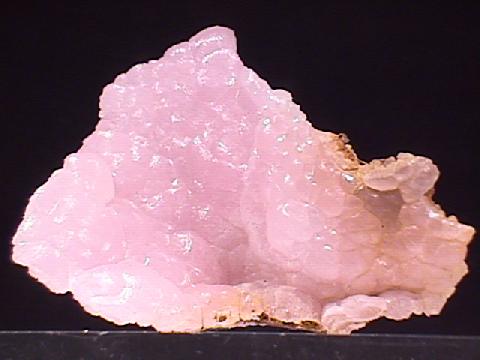
SMITHSONITE specimen smi-47
$ 120.00
$ 120.00
Dims: 2.3 x 1.7 x 1.0" (5.8 x 4.3 x 2.5 cm)
Wt: 1.46 oz. (41.5 g)
Sinaloa, Mexico
This small hand specimen consists almost entirely of a thin, reniform crust of Smithsonite. The crust is made up of scores of small intergrown Smithsonite nodules, and is in excellent condition, showing only a very small amount of fresh damage. Its form is quite good, as all of the nodules therein have a diameter between 0.2 and 0.4" (0.5 and 1.0 cm). It has a lovely pink color (though a small portion is somewhat rust-stained) and a beautiful bright waxy-to-pearly luster that makes me think of melted wax. Only a small amount of host rock is present- it appears to be made of goethite or limonite.

smi-47 ($120.00)
Sinaloa, Mexico
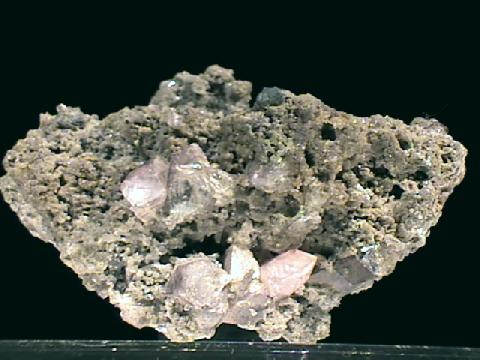
SMITHSONITE specimen smi-48
$ 50.00
$ 50.00
Dims: 3.2 x 1.7 x 1.7" (8.1 x 4.3 x 4.3 cm)
Wt: 3.76 oz. (106.6 g)
Tsumeb Mine, Tsumeb, Namibia
At least 20 trigonal prismatic Smithsonite crystals rest in the dull brown, semicrytalline matrix of this hand specimen. These crystals reach a maximum length of 0.5" (1.3 cm) and are in moderately good condition, as several are damaged or broken. Those that are intact, however, have excellent form, with well-defined edges and clean faces- a few possess second terminations that are incomplete due to intergrowth with the matrix. All have a pale pink coloration and a dull pearly luster, and are dimly transparent due to cloudy inclusions and internal fractures. The matrix in which they rest appears to be made of countless tiny, intergrown crystals of what is most likely more Smithsonite, as it effervesces in concentrated hydrochloric acid, though much more slowly than calcite would.
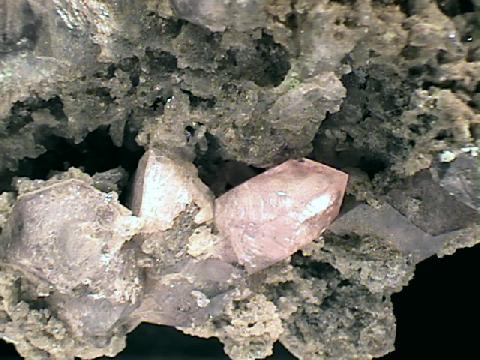

smi-48 ($ 50.00)
Tsumeb Mine, Tsumeb, Namibia
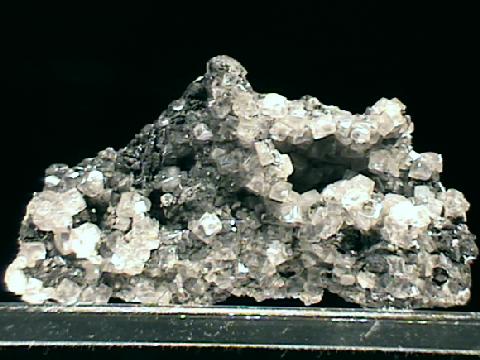
SMITHSONITE specimen smi-49
$ 70.00
$ 70.00
Dims: 3.0 x 1.9 x 1.5" (7.6 x 4.8 x 3.8 cm)
Wt: 5.99 oz. (169.9 g)
Tsumeb Mine, Tsumeb, Namibia
At least 100 small, pseudocubic Smithsonite crystals rest on the dark gray host rock of this piece. These crystals do not exceed 0.1" (3 mm) in diameter as a rule, but are generally in very good condition, as little damage is visible. Their trigonal form is quite good, with well-defined edges and clean faces that possess a dull pearly luster. They are basically colorless and dimly transparent, showing a very thin cloudiness. A few have a very faint pink tinge. The base on which they rest appears to be made out of a semicrystalline metallic sulfide such as bornite (that is what I think it is).
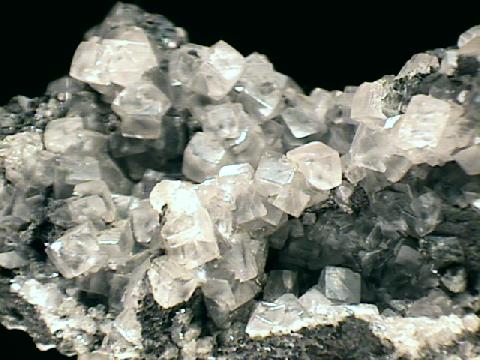

smi-49 ($ 70.00)
Tsumeb Mine, Tsumeb, Namibia
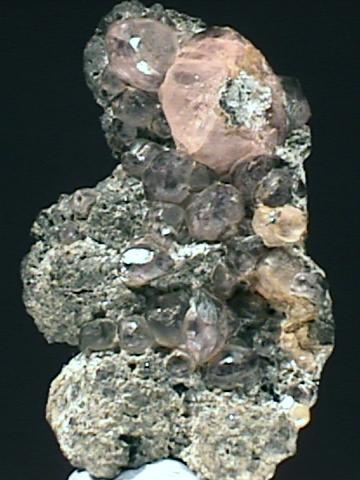
SMITHSONITE specimen smi-50
$ 45.00
$ 45.00
Dims: 1.2 x 0.7 x 0.4" (3.0 x 1.8 x 1.0 cm)
Wt: 15.2 g
Tsumeb Mine, Tsumeb, Namibia
This thumbnail specimen consists of a cluster of at least 20 rounded Smithsonite crystals. These crystals are quite small- the largest has a diameter of 0.4" (1.0 cm), and the rest are less than half that size. All appear to be in good condition, showing very little damage. Their trigonal form is rather warped and rounded, but one can still see definite edges and faces. Their color is pink and their luster is pearly, and all are transparent and dimly clear. They are partly embedded in what appears to be a galena base.

smi-50 ($ 45.00)
Tsumeb Mine, Tsumeb, Namibia
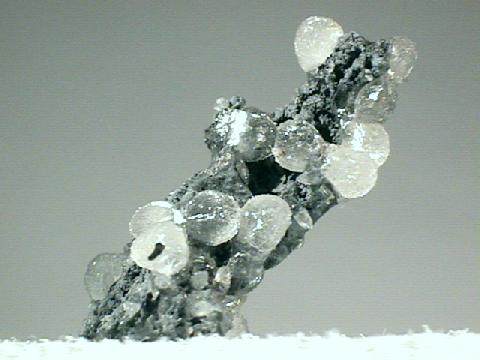
SMITHSONITE specimen smi-51
$ 25.00
$ 25.00
Dims: 0.1 x 0.6 x 0.3" (2.5 x 1.5 x 0.8 cm)
Wt: 11.1 g w/ specimen box
Broken Hill Mine, New South Wales, Australia
This thumbnail specimen consists of several round Smithsonite nodules resting on a stalactitic coronadite base. The nodules do not exceed 0.1" (2 mm) in diameter and are generally in good condition- only one appears to be damaged. All are colorless and dimly transparent, and all have the classic pearly "melted wax" luster of their species. The piece is glued into a plastic specimen box.

smi-51 ($ 25.00)
Broken Hill Mine, New South Wales, Australia
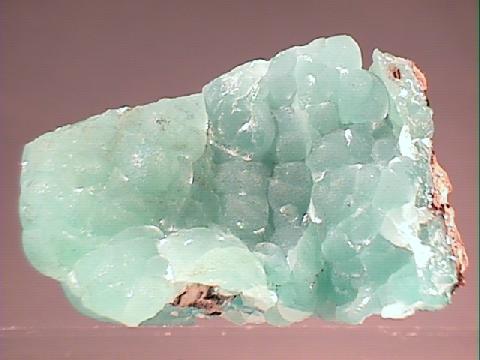
SMITHSONITE specimen smi-52
$ 70.00
$ 70.00
Dims: 2.0 x 1.4 x 1.1" (5.1 x 3.5 x 2.8 cm)
Wt: 2.67 oz. (75.6 g)
Kelly Mine, New Mexico, U.S.A.
This small hand specimen consists of a partial Smithsonite crust that almost completely covers a thin vein of dull, gray-white Smithsonite. The crust is about 0.2" (5 mm) thick and shows a lovely aqua-blue color with strong hints of green in some areas and a slightly dull, silky luster that makes me think of melted wax. The crust is easily translucent and nearly -but not quite- transparent, and shows an excellent botryoidal habit. It is broken along its edges and damaged on its surface in one or two places.
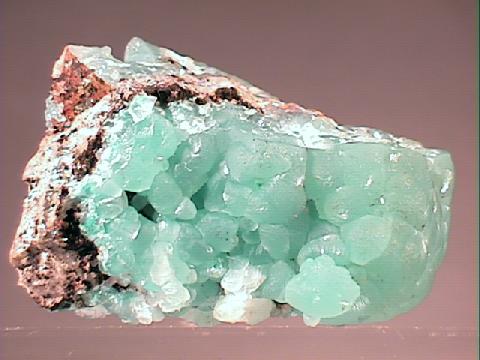

smi-52 ($ 70.00)
Kelly Mine, New Mexico, U.S.A.
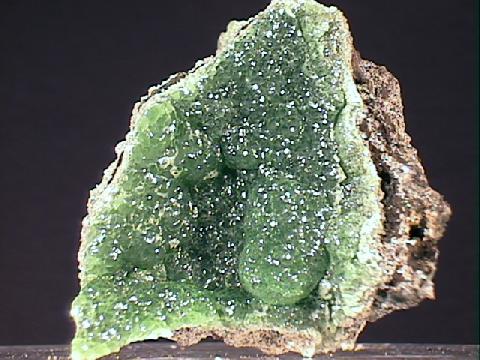
SMITHSONITE specimen smi-53
$ 85.00
$ 85.00
Dims: 2.3 x 2.0 x 1.4" (5.8 x 5.1 x 3.6 cm)
Wt: 3.58 oz. (101.5 g)
79 Mine, Hayden, Gila County, Arizona, U.S.A.
Several crusts of green Smithsonite rest on the dull Smithsonite/goethite base of this hand specimen. The largest of these crusts is the most striking, as it has a beautiful, deep grass-green coloration and a bright, silky luster. The crust is no more than 0.1" (3 mm) thick and shows an excellent botryoidal habit. A few other green crusts and veins lie elsewhere in the host rock, but none have the intensity of color or luster that the large one has.

smi-53 ($ 85.00)
79 Mine, Hayden, Gila County, Arizona, U.S.A.
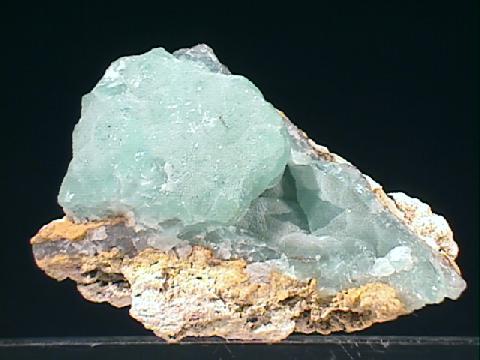
SMITHSONITE specimen smi-54
$ 28.00
$ 28.00
Dims: 2.3 x 1.7 x 0.9" (5.7 x 4.3 x 2.4 cm)
Wt: 2.38 oz. (67.7 g)
Kelly Mine, New Mexico, U.S.A.
A few intersecting Smithsonite veins and crusts extend through and partly coat the dull, pale brown matrix of this hand specimen. The crust shows light damage on parts of its surface but has the botryoidal form that is common for this specie. Its aqua-blue color is common for its locality, and its luster is rather dull due to a very thin coating of a material that I cannot identify. It is translucent, too. The thin vein of Smithsonite that extends into the host rock has an identical appearance and properties.

smi-54 ($ 28.00)
Kelly Mine, New Mexico, U.S.A.
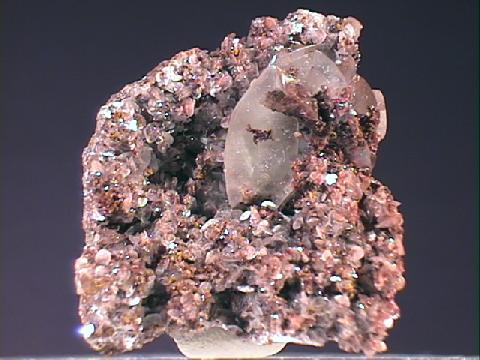
SMITHSONITE specimen smi-55
$ 45.00
$ 45.00
Dims: 1.5 x 1.3 x 0.8" (3.8 x 3.3 x 1.3 cm)
Wt: 26.3 g
3/4 Orebody, Broken Hill Mine, Kabwe, Zambia
This thumbnail specimen consists of perhaps hundreds of tiny, round Smithsonite blades. A few of the blades are quite large, and have dimensions of up to 0.7 x 0.4 x 0.2" (1.8 x 1.0 x 0.4 cm). They are generally in very good condition- very few show any damage- and all have excellent trigonal tabular form, though they are generally round and show no triangular or hexagonal outline. They are essentially colorless, but many contain iron oxide inlclusions, giving them a rusty red-brown color. All have a bright pearly luster with a faintly silky sheen across their surfaces and are dimly transparent. Their base is made of a mixture of more compact Smithsonite and more iron oxide.

smi-55 ($ 45.00)
3/4 Orebody, Broken Hill Mine, Kabwe, Zambia

SMITHSONITE specimen smi-56
$ 25.00
$ 25.00
Dims: 1.89 x 1.1 x 0.7" (4.7 x 2.8 x 1.7 cm)
Wt: 22.7 g
Hilarion Adit, Agios Constantinos, Laurion, Greece
This large thumbnail specimen consists of a section of botryoidal Smithsonite crust. It is in good condition, though one spot does seem to be lightly damaged, and it shows good botryoidal form. The crust has a red-brown color that is likely caused by rusty inclusions, and shows the characteristic "melted wax" luster. It is dappled with dull, black spots of some other mineral and appears to hold a small amount of brown or black goethite or limonite on its underside.

smi-56 ($ 25.00)
Hilarion Adit, Agios Constantinos, Laurion, Greece
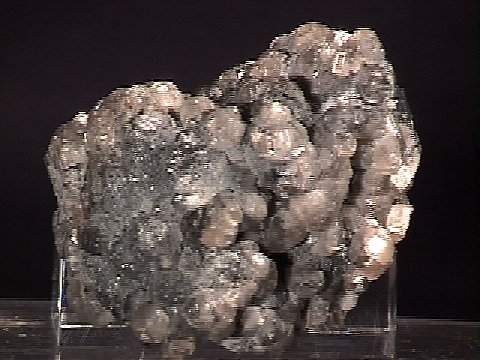
SMITHSONITE specimen smi-57
$ 45.00
$ 45.00
Dims: 1.8 x 1.4 x 1.0" (4.6 x 3.5 x 2.6 cm)
Wt: 2.3 oz. (64 g)
Tsumeb Mine, Namibia
Several dozen minute Smithsonite crystals rest on the galena base of this hand specimen. These crystals do not exceed 0.2" (5 mm) in diameter and are in moderately good condition, as several are crushed and several others are noticeably cloven. Those that are intact have a good trigonal prismatic form that is so blocky as to appear nearly dodecahedral! Their color is a faint, dull pink and their luster is pearly, and all are transparent and moderately clear. The galena base is crystalline and appears to contain small anglesite crystals, though all that is visible are broken bits.

smi-57 ($ 45.00)
Tsumeb Mine, Namibia
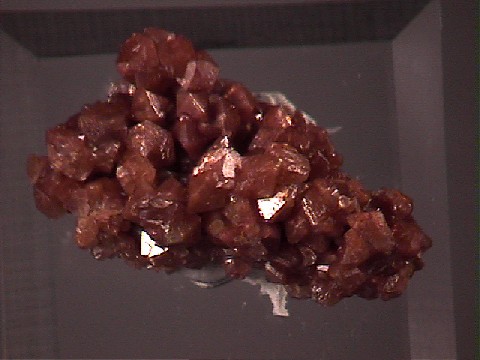
SMITHSONITE specimen smi-58
$ 60.00
$ 60.00
Dims: 1.3 x 0.8 x 0.6" (3.4 x 2.0 x 1.5 cm)
Wt: 12 g
Tsumeb Mine, Tsumeb, Namibia
A cluster of several dozen intergrown Smithsonite crystals comprises this large thumbnail specimen. These crystals are generally in good condition, though several exposed ones are damaged, and do not exceed 0.2" (5 mm) in diameter. They have very good trigonal prismatic form that takes on the shape of a hexagonal bipyramid, though they are slightly warped due to their heavy intergrowth. All have an odd, coppery-red color that is actually caused by copper inclusions! Their luster is pearly and bright, and all are at least dimly translucent. There is no host rock present, and the piece is affixed to a beveled square acrylic base with a removable putty.
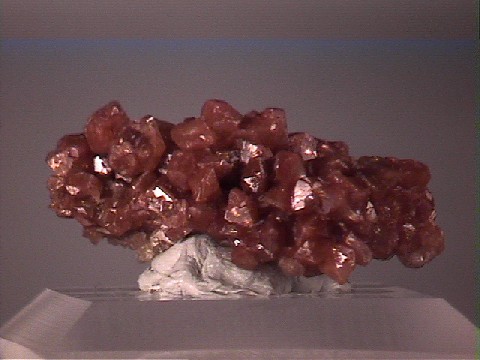

smi-58 ($ 60.00)
Tsumeb Mine, Tsumeb, Namibia
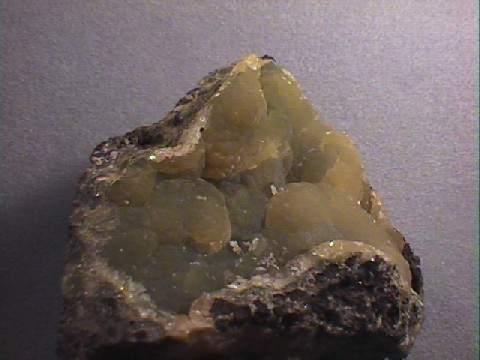
SMITHSONITE specimen smi-59
$ 150.00
$ 150.00
Dims: 3.8 x 3.5 x 2.3" (9.5 x 8.9 x 5.8 cm)
Wt: 1 lb., 5.0 oz. (594 g)
Arizona, U.S.A.
This large display piece consists of a botryoidal Smithsonite crust that coats a brown and black base rock. This crust is in good condition, showing light to moderate damage, and has an excellent botryoidal form. Its broken edges show a compact, almost radiating cross-section. The crust has a rather dull green color with a hint of brown and a dull, silky to waxy luster. The crust appears to be translucent. The black base on which it rests appears to be made of another botryoidal material whose form is caused by concentric layers- I do not know its composition.
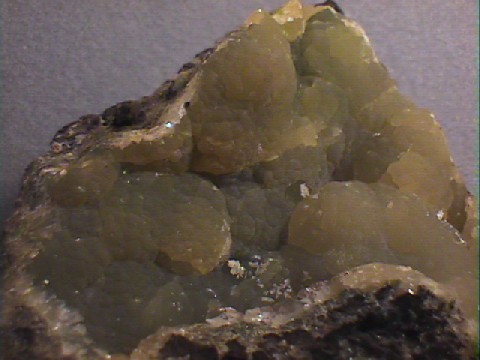

smi-59 ($150.00)
Arizona, U.S.A.
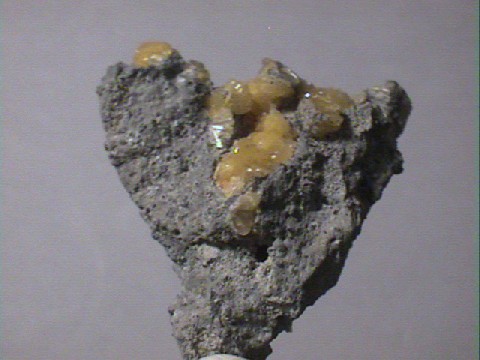
SMITHSONITE specimen smi-60
$ 30.00
$ 30.00
Dims: 1.5 x 1.5 x 0.8" (3.9 x 3.7 x 2.1 cm)
Wt: 0.6 oz. (16 g)
Rush, Arkansas, U.S.A.
Several small Smithsonite sprays rest on the gray base rock of this hand specimen. These round clusters are generally in good condition, though some of them are broken and incomplete, and reach diameters of approximately 0.2" (4 mm). Each of these round clusters is made up of scores of compact, radiating Smithsonite blades or prisms that show reasonably good trigonal form. All have a pale orange color and a pearly luster and are translucent to dimly transparent.

smi-60 ($ 30.00)
Rush, Arkansas, U.S.A.
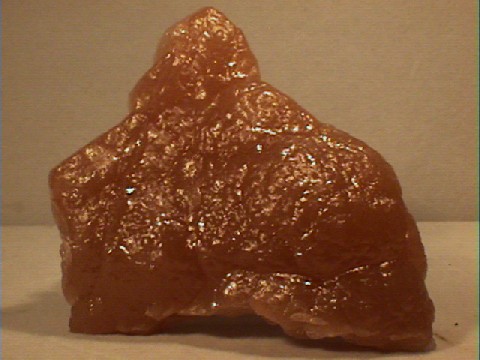
SMITHSONITE specimen smi-62
$ 45.00
$ 45.00
Dims:2.7x2.2x0.7" (6.9x5.6x1.8 cm)
Wt: 4.3oz. (121g)
Sierra Mojada, Coahuila, Mexico
This specimen consists of a crust of reniform smithsonite. Other than a bit of calcite on the back, there is no matrix present. This piece is an interesting honey color, with a greasy luster. On the edges, one can see banding, similar to agate, showing the layers of deposition. There is no damage to the face of this specimen.

smi-62 ($ 45.00)
Sierra Mojada, Coahuila, Mexico
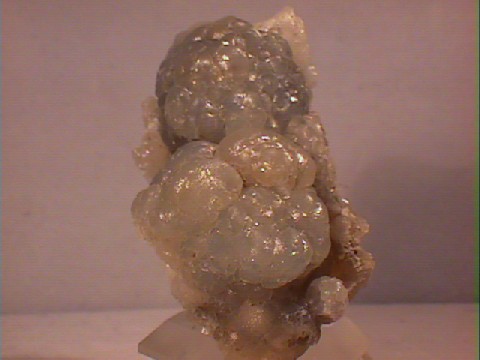
SMITHSONITE specimen smi-61
$ 45.00
$ 45.00
Dims:2.6x1.7x1.2" (6.6x4.3x3.0 cm)
Wt: 3.5oz. (98g)
Kelly Mine, Magdalena, New Mexico
This specimen consists of a thick crust of botryoidal smithsonite, exhibiting the characteristic Kelly Mine green color and habit. There is only tiny fragments of matrix rock present on this specimen, and the only visible damage is on the edges, where it was broken from the matrix. On these broken edges one can see the layering effect as this mineral was deposited.

smi-61 ($ 45.00)
Kelly Mine, Magdalena, New Mexico
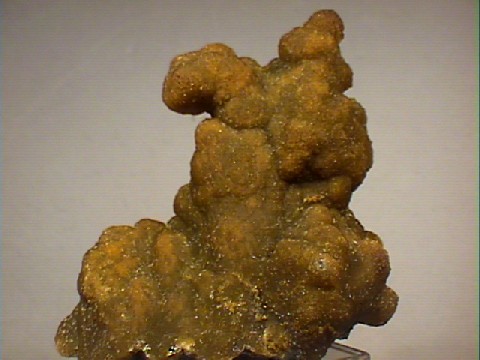
SMITHSONITE specimen smi-63
$ 42.00
$ 42.00
Dims:3.0x2.9x1.7" (7.6x7.4x4.3 cm)
Wt: 7.8oz. (220g)
Lvl 8, San Antonio el Grande Mine, Santa Eulalia, Chihuahua, Mexico
Except for the base of this specimen, the matrix is completely covered with a crust of brown smithsonite. The smithsonite is in a pisolitic form, with a pearly luster. The only damage to this specimen is at the base.

smi-63 ($ 42.00)
Lvl 8, San Antonio el Grande Mine, Santa Eulalia, Chihuahua, Mexico
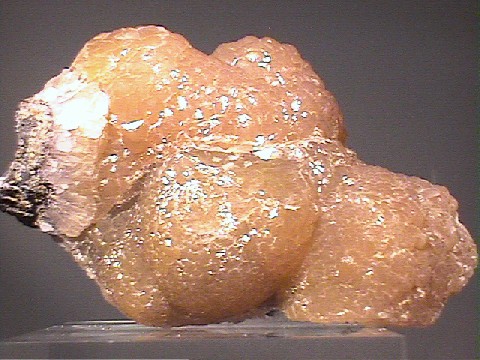
SMITHSONITE specimen smi-64
$ 110.00
$ 110.00
Dims: 2.9x2.1x1.2" (7.5x5.4x3.0 cm)
Wt: 6.4 oz. (181 g)
Choix, Sinaloa, Mexico
This hand specimen is covered with a thick botryoidal crust of translucent flesh-colored smithsonite exhibiting the characteristic melted-wax luster of this specie. The play of light on the surface of the specimen is very appealing. Other than the edges of the specimen, where it was separated from its bretren, this specimen is undamaged.
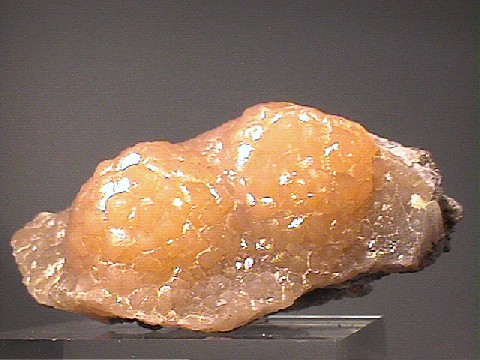

smi-64 ($110.00)
Choix, Sinaloa, Mexico
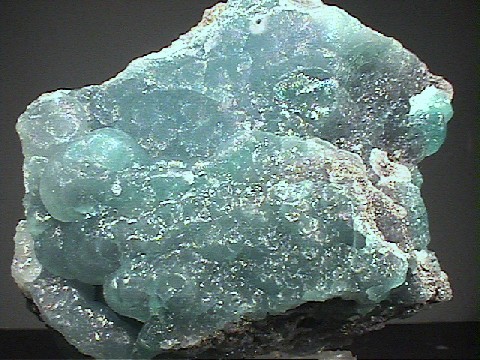
SMITHSONITE specimen smi-65
$ 90.00
$ 90.00
Dims: 2.6x2.1x1.2" (6.7x5.4x3.0 cm)
Wt: 5.3 oz. (150 g)
Choix, Sinaloa, Mexico
This hand specimen of smithsonite is a pretty sea blue-green color. The translucent crust has both the melted-wax luster characteristic of smithsonite, and also exhibits a rainbow irridescence that is rather unusual and very appealing. The smithsonite is on both sides of the specimen (one side is more blue), and there is very little damage visible.
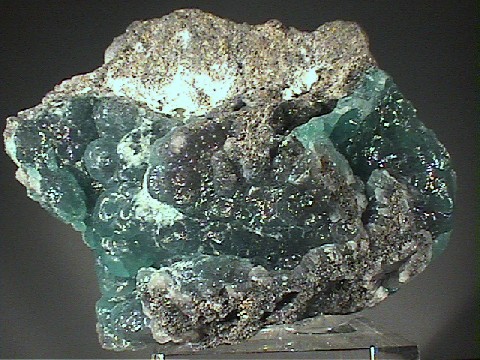

smi-65 ($ 90.00)
Choix, Sinaloa, Mexico
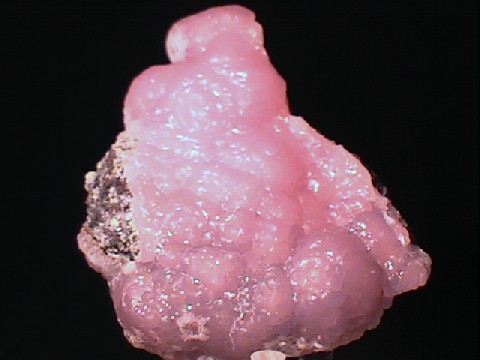
SMITHSONITE specimen smi-66
$ 70.00
$ 70.00
Dims: 2.4x1.7x0.9" (6.0x4.3x2.3 cm)
Wt: 3.0 oz. (84.2g)
Choix, Sinaloa, Mexico
This is a lovely pink hand specimen of smithsonite as a crust (several mm thick) over some kind of matrix. On one side of the specimen, the pink color shades towards purple, but it does not quite get there. The melted-wax luster and play of light is excellent. I do not detect any damage, other than around the edges and an area where the smithsonite has apparently broken off. There are some small areas coated with a very thin crust of calcite.
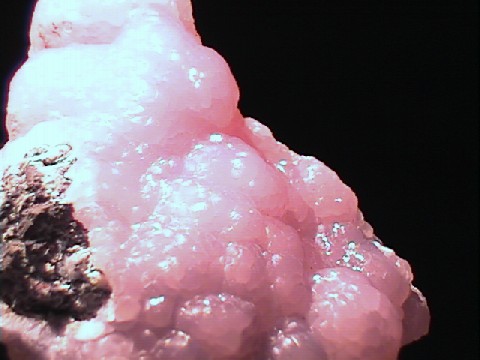

smi-66 ($ 70.00)
Choix, Sinaloa, Mexico
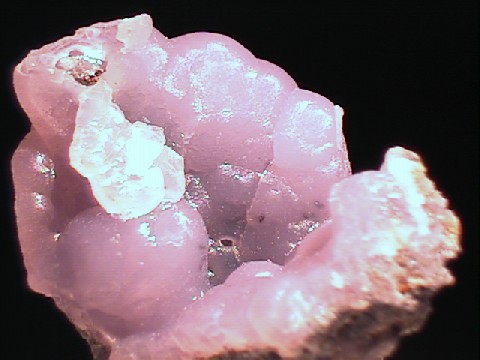
SMITHSONITE specimen smi-67
$ 50.00
$ 50.00
Dims: 1.8x1.1x1.4" (4.7x2.9x3.5 cm)
Wt: 2.5 oz. (70.5g)
Choix, Sinola, Mexico
This rather cute little smithsonite specimen is a pale lavendar color. It is a crust over an odly shaped host rock, giving it an interesting three-dimensional appearance. It has the standard melted-wax luster of smithsonite, and shows a faint irridescence. What I first thought was separation damage at the top of the crystal is not. Under a loupe, this is an area of incomplete growth, with all natural terminations. There are two small fragments of another crystal attached to this one, and THIS crystal fragment is clearly damaged.
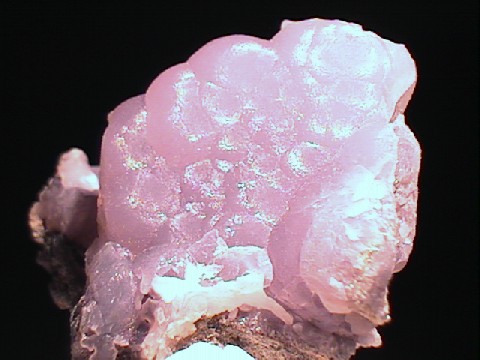

smi-67 ($ 50.00)
Choix, Sinola, Mexico
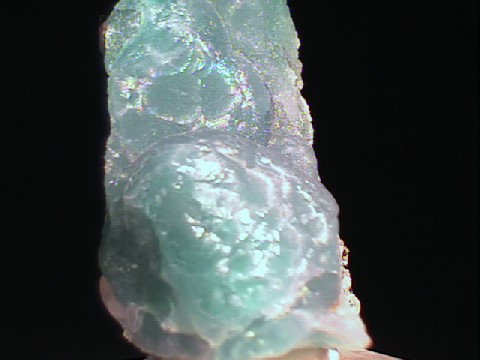
SMITHSONITE specimen smi-68
$ 40.00
$ 40.00
Dims: 1.6x1.1x1.3" (4.2x2.8x3.4cm)
Wt: 2.18 oz. (61.6g)
Choix, Sinaloa, Mexico
Like other Choix smithsonites, this one shows excellent luster, color, and irridescence. The color varies from an aqua green to a soft purple-green. The specimen is fairly dense, being mostly smithsonite by weight. The broken edges of the specimen reveal the radial / botryoidal patterns of the crystals.

smi-68 ($ 40.00)
Choix, Sinaloa, Mexico
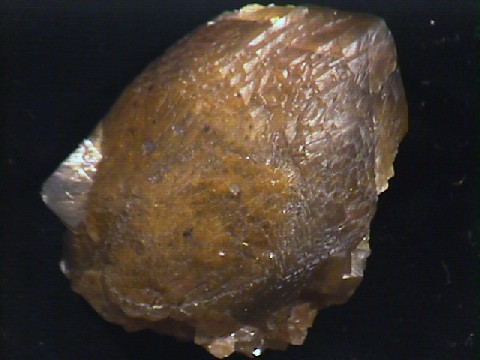
SMITHSONITE specimen smi-69
$ 40.00
$ 40.00
Dims: 1.57x1.14x0.87" (4.0x2.9x2.2cm)
Wt: 1.85oz. (52.3g)
Tsumeb Mine, Tsumeb, Otaviberge, Namibia
This is a very unusual smithsonite specimen. It consists of two intergrown crystals, the smallest of which appears cubic, but the largest (90% of the specimen) is hexagonal with a stepped (nearly rounded) pyramidal termination. Its luster is pearly, the crystal is brown and translucent, with some areas around the edge have some damage and the exposed crystal edges appear nearly transparent.
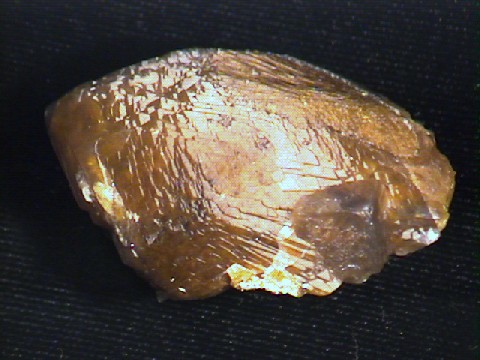

smi-69 ($ 40.00)
Tsumeb Mine, Tsumeb, Otaviberge, Namibia
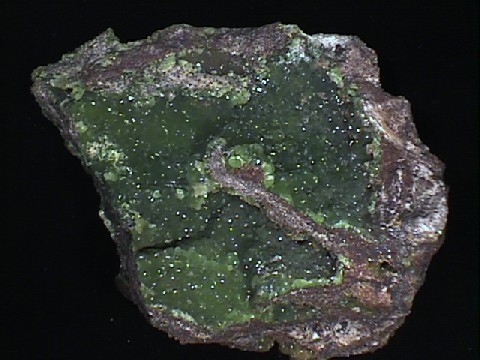
SMITHSONITE specimen smi-70
$ 68.00
$ 68.00
Dims: 4.21x3.39x1.77" (10.7x8.6x4.5cm)
Wt: 13.71oz (388.0g)
79 Mine, Gila County, Arizona, USA
I'm trying to decide how to describe the color of this smithsonite specimen. It is a pretty shade of green, and the color is close to a "Granny Smith apple", but that is modified by the botryoidal translucent surface, and it is a bit darker in hue also. It is a pretty color, and this smithsonite coats all crevices and fills some veins on the host rock,covering most of the front and about half of the back of the specimen. On the back, there is a surprise mineral - I do not know what it is, but it is a bright turquoise blue, translucent, and it does not have a well-defined crystal shape. A loupe reveals that there are tiny crystals of this mineral scattered all over the specimen.
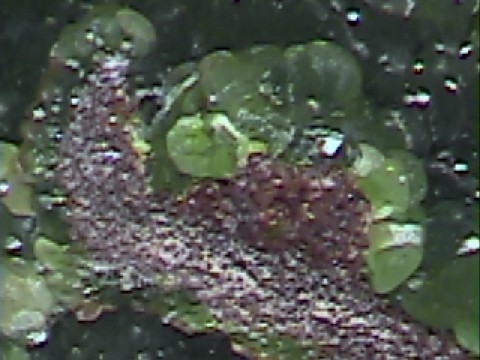

smi-70 ($ 68.00)
79 Mine, Gila County, Arizona, USA
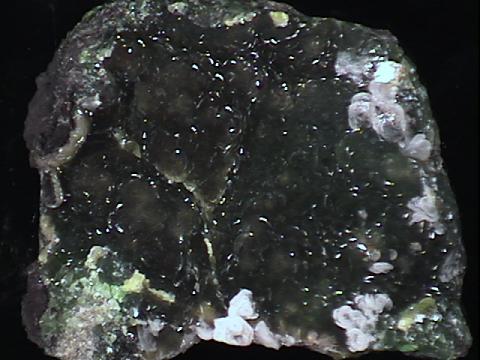
SMITHSONITE specimen smi-71
$ 55.00
$ 55.00
Dims: 2.61x2.22x1.40" (6.63x5.63x3.55cm)
Wt: 6.67oz (188.7g)
79 Mine, Gila County, Arizona, USA
This is a pretty hand specimen of smithsonitge. It has a lovely deep apple-green color, with the usual botryoidal form and melted-wax luster of smithsonite. It also is graced with several clusters of white crystals providing a nice contrast. These might be hemimorphite, or even gypsum, as they have rounded flat crystals with curved faces, organized in little flowers.
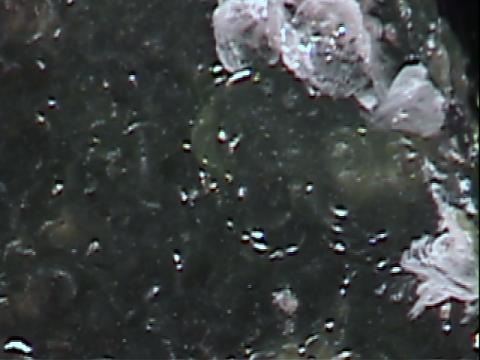

smi-71 ($ 55.00)
79 Mine, Gila County, Arizona, USA
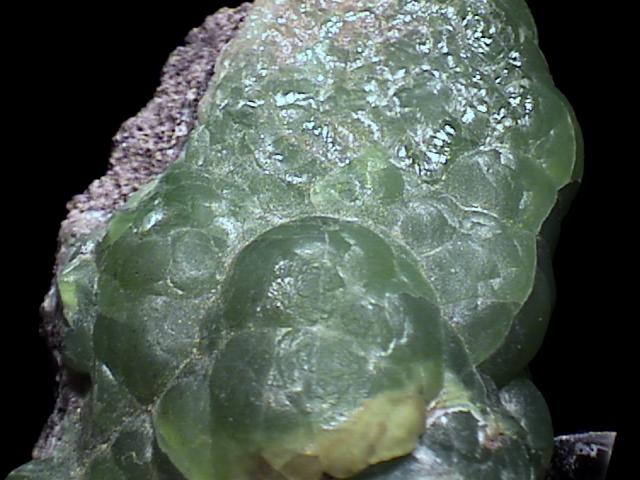
SMITHSONITE specimen smi-72
$ 72.00
$ 72.00
Dims: 2.32x1.37x1.37" (5.90x3.48x3.49cm)
Wt: 3.89oz (110.2g)
79 Mine, Gila County, Arizona, USA
This sample of smithsonite has a lovely lime-green color, and the usual botryoidal habit and melted-wax luster. There is a band of yellow-green smithsonite, and a larger area where the smithsonite's luster approaches vitreous (it almost looks silvery in this area). One end of the smithsonite has been broken away, revealing the underlying rock, and more interstingly, a millimater thick gap between the overlying lime green and underlying gray-green smithsonite.
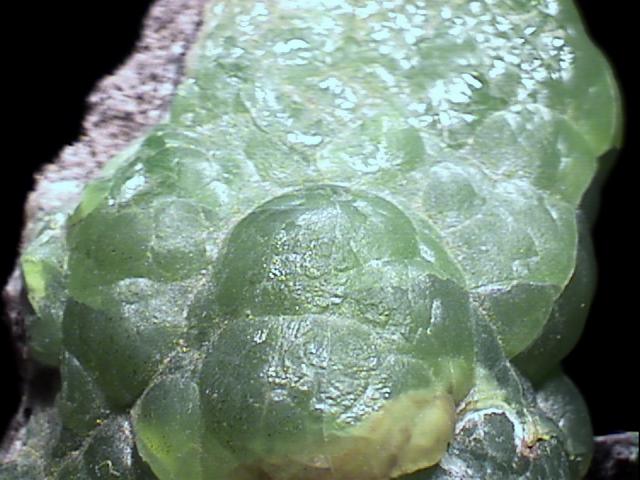

smi-72 ($ 72.00)
79 Mine, Gila County, Arizona, USA
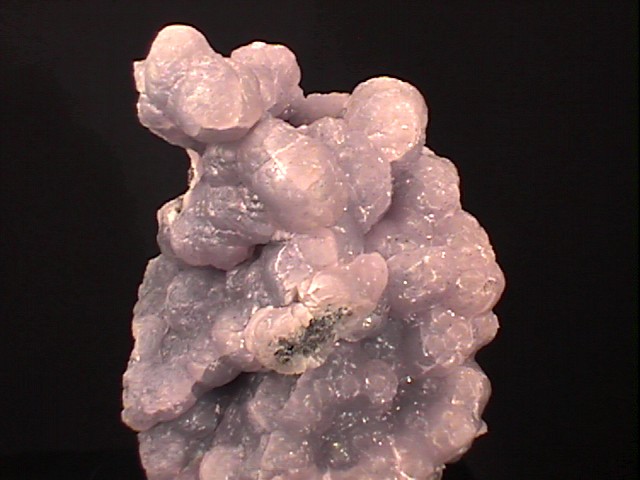
SMITHSONITE specimen smi-73
$ 130.00
$ 130.00
Dims: 3.41x2.74x2.11" (8.66x6.96x5.35cm)
Wt: 15.20oz (431g)
Choix, Sinaloa, Mexico
This specimen has a crust of botryoidal smithsonite on most of the top surface of a non-descript host rock. The smithsonite has a delicate lavender color with a hint of pink. It is translucent, and has the usual melted-wax luster. In addition, the surface displays an irridescence in hues of purple, blue, and green. The smithsonite is relatively thick, ranging from 5mm to perhaps 8mm. In a few places long the edge, the smithsonite's radial growth pattern is exposed. There is one spot about 2cm in width towards the center of the specimen where it appears that a section of smithsonite broke away from the host, and this area is quite fascinating to examine with a loupe, as there are hundreds of tiny crystals with odd, rounded shapes exposed here.
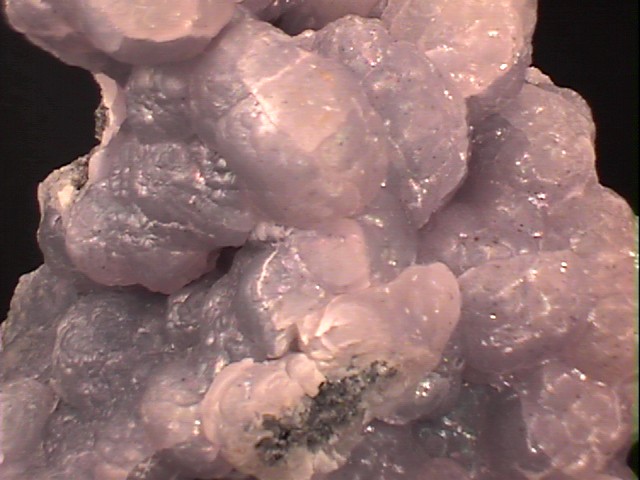

smi-73 ($130.00)
Choix, Sinaloa, Mexico
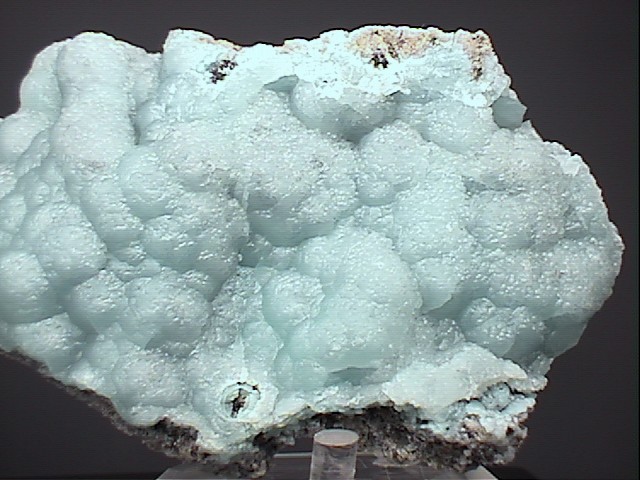
SMITHSONITE specimen smi-74
$ 45.00
$ 45.00
Dims: 3.19x1.73x0.94" (8.11x4.38x2.38cm)
Wt: 5.20oz (147.5g)
Choix, Sinaloa, Mexico
This smithsonite specimen has a lovely light sky-blue color, a typical shape of intergrown botryoidal masses, and a luster that glistens but is rougher than most smithsonite. Yet a loupe reveals that the rough luster is just a matter of scale - the typical waxy luster, plus an irridescent surface, is obvious through the loupe. Also, the color is revealed as a colorless layer of smithsonite over a base of blue-green smithsonite. Lastly, there are several exposed pockets on the top and sides which show an interesting formation, even looking a bit like an ice cave.
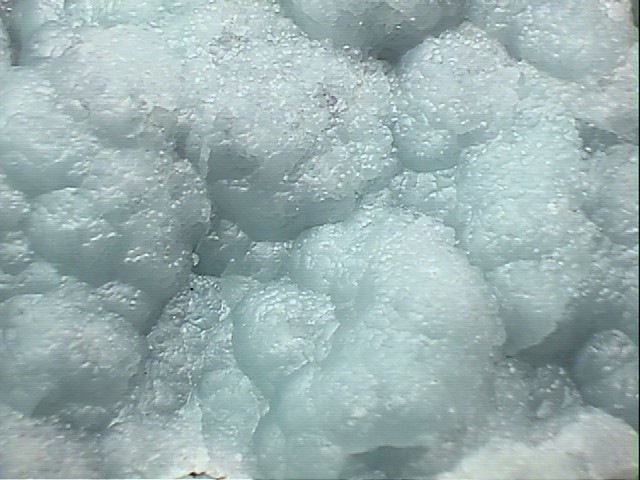

smi-74 ($ 45.00)
Choix, Sinaloa, Mexico
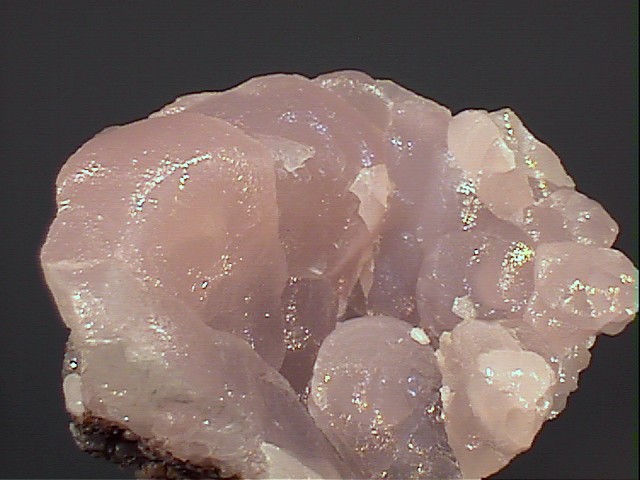
SMITHSONITE specimen smi-75
$ 30.00
$ 30.00
Dims: 2.06x1.63x1.29" (5.24x4.13x3.27cm)
Wt: 3.41oz (96.6g)
Choix, Sinaloa, Mexico
The thick layer of smithsonite on this specimen has a very pale pink color. It does exhibit a botryoidal habit, although the "balls" are large and obtuse enough to qualify as mammilary. The smithsonite has the usual melted-wax luster, and the broken edges of the specimen display the radial growth pattern of the smithsonite.
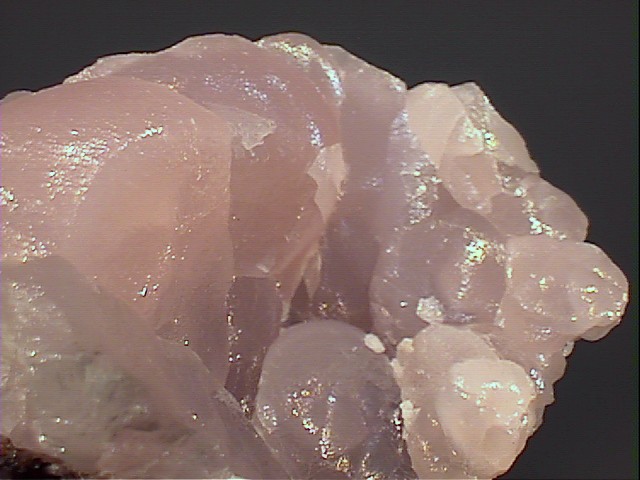

smi-75 ($ 30.00)
Choix, Sinaloa, Mexico

SMITHSONITE specimen smi-76
$ 105.00
$ 105.00
Dims: 3.43x2.30x1.85" (8.71x5.84x4.70cm)
Wt: 12.31oz (349g)
Choix, Sinaloa, Mexico
This smithsonite specimen is ugly enough to be pretty, if you know what I mean. A host rock which appears to be limonite, goethite, and colorless smithsonite largely intergrown with each other (yielding a gray-brown-black color), is overgrown with colorless smithsonite, which itself is largely covered with pink smithsonite on one side, purple smithsonite on another, and a sparkly gray-pink crust on a third. A loupe reveals that this crust is actually a thin layer of tiny, bright pink balls of transparent smithsonite over a goethite base. In places these balls grow together yielding a typical botryoidal smithsonite appearance (at least through a loupe). About half of the surface are fractures where this specimen was removed from the host rock.


smi-76 ($105.00)
Choix, Sinaloa, Mexico

SMITHSONITE specimen smi-77
$ 25.00
$ 25.00
Dims: 2.37x2.34x1.80in (6.02x5.94x4.56cm)
Wt: 8.29oz (235g)
Choix, Sinaloa, Mexico
A crevice in a chunk of host rock is partially filled with a yellow druze of smithsonite. Four separate cavities are exposed, and the crystals in one of them are excellent, showing the characteristic melted-wax luster of smithsonite. The somewhat unusual creamy-yellow color is very nice.


smi-77 ($ 25.00)
Choix, Sinaloa, Mexico

SMITHSONITE specimen smi-79
$ 25.00
$ 25.00
dims mm=67.43x23.38x14.41
wt g=56.5
Choix, Sinaloa, Mexico
While the overall color of this smithsonite specimen is a medium pale purple, it reflects some irridescent metallic hues of blue. A few of the mamillary crystals are pink, and the luster has the pleasing appearance typical of smithsonite.


smi-79 ($ 25.00)
Choix, Sinaloa, Mexico

SMITHSONITE specimen smi-83
$ 28.00
$ 28.00
dims mm=92.85x47.72x12.30
wt g=90.2
Choix, Sinaloa, Mexico
This piece of smithsonite has excellent luster and form. Its only crime is that the color is a very pale gray, essentially an off-white. It also has a very subtle metallic iridescence.


smi-83 ($ 28.00)
Choix, Sinaloa, Mexico

SMITHSONITE specimen smi-84
$ 25.00
$ 25.00
dims mm=60.50x31.47x19.37
wt g=53.1
Choix, Sinaloa, Mexico
This small specimen of smithsonite has an excellent pink color and shows the characteristic luster and botryoidal form that makes smithsonite such a popular mineral.


smi-84 ($ 25.00)
Choix, Sinaloa, Mexico

SMITHSONITE specimen smi-78
$ 45.00
$ 45.00
dims mm=76.24x47.31x30.05
wt g=147.8
Choix, Sinaloa, Mexico
I'm not certain about the true color of this piece of smithsonite. It is mostly gray, but to my eye it has a purple tint and some metallic colorful irridescence. However, when I look at it with my loupe, the surface appears brightly irridescent in soft hues of many colors, and perhaps the overall purple tint is simply a combination of these colors adding to the surface luster.


smi-78 ($ 45.00)
Choix, Sinaloa, Mexico